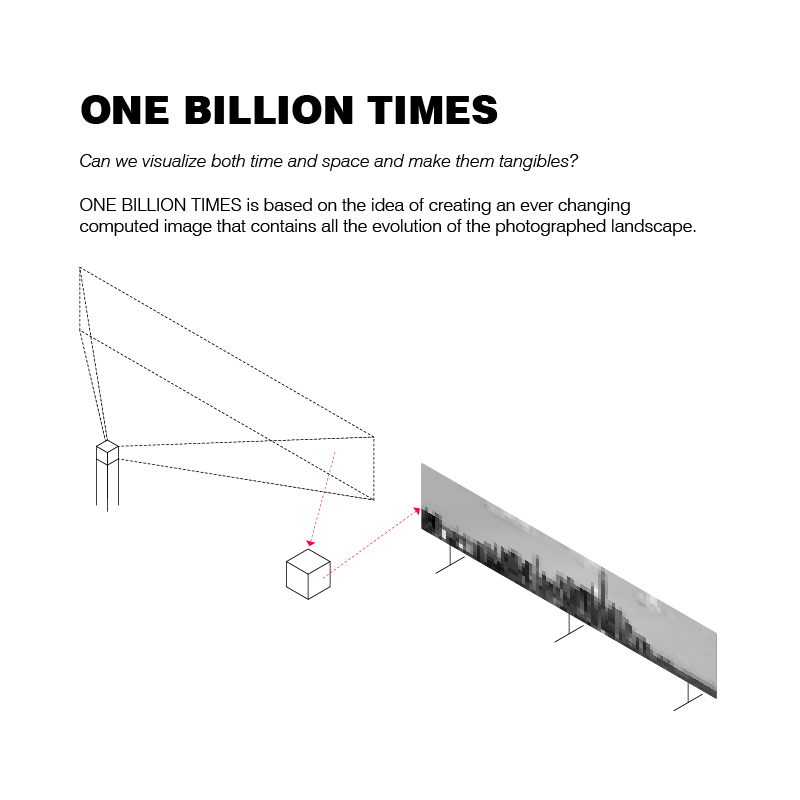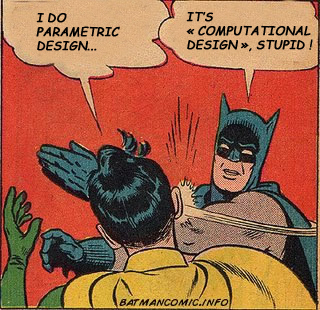
Can we visualize both time and space and make them tangibles?
ONE BILLION TIMES is based on the idea of creating an ever changing
computed image that contains all the evolution of the photographed landscape.
Interesting links:

Can we visualize both time and space and make them tangibles?
ONE BILLION TIMES is based on the idea of creating an ever changing
computed image that contains all the evolution of the photographed landscape.
Interesting links:
There is big trend about parametric approach and computation in design and architecture. In the last months, I’ve repeatedly been involved in discussions about if it would be more exact to call what we do as designers “computational design” or “parametric design”. It is not a useful discussion, I have to say.
I have the feeling that computational design is more trendy and parametric design is more nineties, would you agree with that ? As Aldo from Noumena Architecture said during our last workshop : “Don’t say parametric design!”.
I don’t know. “Computational design” refers to the use of computers and mathematical approach to the generation of geometries, objects and architecture. “Parametric design” is about using parameters to design things. It means that if parameters changes, the result change. Regardless of which expression is the best, what interests me the most is the idea of focusing on design process instead of designed objects.
the most interesting shift in design is that we have passed from designing object to designing networks and processes http://t.co/iwg54WHo
— Francesco Cingolani (@immaginoteca) September 29, 2012

The process is everything (Mies would say that “God is in the process”) and that’s why I think that “parametric design” is still an interesting way to explain our approach. Parameters is about changing conditions and adaptability to user needs. We need to design process instead of objects.
François Roche recently published on his blog our emails exchanges about these topics. If you know him a bit, you would not be surprised to see that he’s not very polite. If you don’t speak French, try to google translate the post.
François Roche says that “computation is a good think, not parametric design…it’s like confusing science with the power of science”.
I answered “Personally, I’m more interested in action than language.” Continue reading Parametric VS Computational Design
photo: “bed” by Emilie Eagan | flickr.com
QUARTO : a room in Madrid
A project by Francesco Cingolani and networks around him.
immagine:
una mia foto adattata con
network visualization di See-ming Lee [flickr]
“Tutto quello che faccio lo faccio in rete, collegandomi ad altre persone, gruppi, studi e associazioni, secondo strutture orizzontali e aperte.”
Con questa frase spiego l’essenza dell’approccio network thinking in un’intervista realizzata dal magazine whymarche nella quale racconto il mio percorso di architetto italiano all’estero e cerco di spiegare che lavoro faccio.
Ecco l’intervista completa.
Continue reading network thinking: un’intervista a Francesco Cingolani

Image: Creative Networking by Amber Case (Flickr)
_
The article begins by explaining a networked-learning project carried out at Ecosistema Urbano, called Urban Social Design Experience, and explains how this project allowed to define network design methodology. At Ecosistema Urbano we are actually applying network design in the project dreamhamar.
_
The article has been originally written in Spanish for La Ciudad Viva and then it has been translated by @la_madalena for dreamhamar blog
_
“Learning is not a product of schooling but the lifelong attempt to acquire it.” – Albert Einstein
For several months we have been developing in Ecosistema Urbano a project focused on expanded education. These last few weeks, we gave it a close look and we would like to share our thougths with you.
The project in question is Urban Social Design Experience (USDE) and we presented the first session – which ended recently – as a series of online courses (experiences). During these experiences innovative approaches and lines of work in urban culture and urban management were presented.